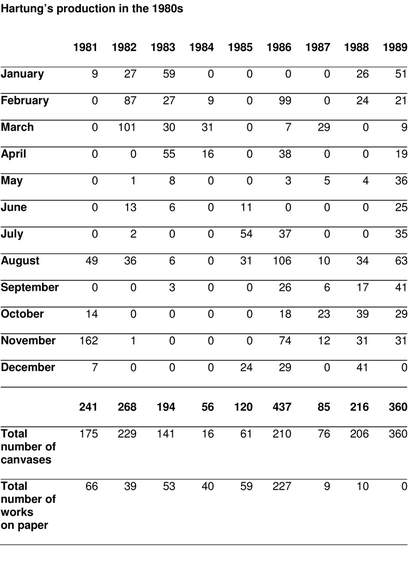Issues surrounding the very late style of artists remain relatively unexplored …
Gary Garrels on de Kooning, 19951
The title sequence of the film commences: ‘HARTUNG 1989. That year he turned eighty-five. He painted 360 paintings. He died 7 December.’ These brief sentences – all there is by way of commentary in the film – can perhaps be said to encapsulate the problem of the very late style of Hans Hartung. Towards the end of December 1986 Hartung had suffered a severe stroke and subsequently required nursing to help him dress and bathe. In his last years he was no longer able to stand, and relied on a wheelchair and the help of others to move. He had lost much of his fine motor control and signing documents became something that might only be attempted on ‘good’ days, which became fewer and fewer over the period 1987–9. In his last year his short-term memory became patchy, to the point where he might forget the names of his assistants, and conversations were limited in scope. More distressing for those around him, Hartung’s character seems to have changed. From being a man who was ever in control, precise and decisive, he became quiescent, accepting, and either unwilling to impose his will on the running of his studio or incapable of doing so. This change in disposition made the task of looking after Hartung the invalid much easier. But it poses fundamental questions about the authorship role of Hartung the artist, who as the film’s title sequence stated, achieved in his very late years what for most other painters would have been a phenomenal rate of production. Following his recovery from the stroke in March of that year, he completed eighty-five canvases in 1987, 202 in 1988, and, as the film noted triumphantly, 360 canvases in 1989.
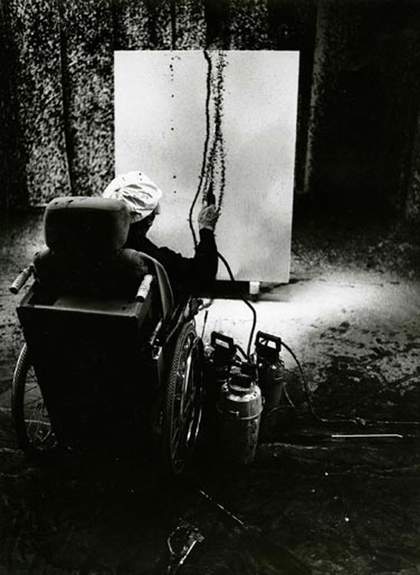
Fig.1
Hartung with a sprayer in his studio in Antibes 2 October 1989
Photo: André Villers © Fondation Hartung Bergman
The film, shot by assistants over a period of several months in 1989 and edited into a montage of sequences in 1996 for an exhibition of Hartung’s late works,2 attempted to deal with two of the most obvious questions posed by these very works. First, did Hartung – a man too physically incapacitated to stand and at times too confused to converse fluently – actually paint these canvases which were often spectacular in scale and dominated by imagery that spoke of explosive energy? Secondly, was Hartung in full control of the technical means used in the production of his late canvases?
The film would appear to deal with the first question, and, as we shall see, the second has tended to be answered in the affirmative by a number of writers. But it is perhaps helpful to return to these fundamental questions in order to arrive at a reasoned assessment of the significance of these late works and their place in Hartung’s oeuvre as a whole. After all, depending on one’s response to these questions, the late canvases can be seen as either a triumphant culmination of essential aspects of Hartung’s approach to his craft or a mere postscript to a career which deserves to be remembered for other works.
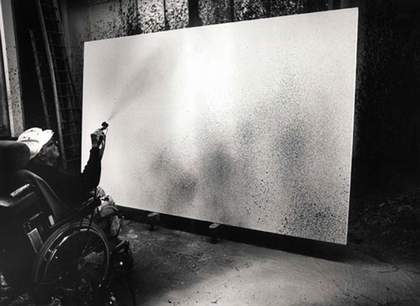
Fig.2
Hartung with a sprayer 1989
Photo: André Villers © Fondation Hartung Bergman
Hartung 1989 comprises sequences of the artist at work. Throughout the film Hartung is shown in his wheelchair before a succession of changing canvases. These are brought and taken away by two assistants, who step gingerly over the paint-spattered studio floor. (Hartung’s use of ‘pulverisateurs’, or sprayers, to shoot paint of various degrees of liquidity at a canvas left a slippery mess on the ground.) The film was shot on different occasions in the spring and summer of that year. Some sequences show a video-recorder date, others do not; but they are not presented in the edited film in chronological order.
This is perhaps a clue to the fact that the film, however informative, was not quite a neutral record of the making of the works. In the mind of the film’s editor there was clearly a need to use the film to focus on the creativity of the artist rather than on what may have been perceived as the less interesting aspect of the process of producing the paintings. In the beginning of the film, for example, Hartung is shown from the left; the work of getting the various canisters of paint ready for use, which took place on the right and behind the artist, is not shown until halfway through. Also, in the first half of the film, editing has eliminated pauses in the process. With the use of cuts and lap-dissolve, tools change in the artist’s hand; similar tools produce different thicknesses of paint with no apparent change to the sprayer’s nozzle; and assistants, when they are shown, are at times reduced to ghostly traces. Significantly, the film is silent and does not record the admittedly minimal conversation that took place between Hartung and the assistants in these sessions.
This lack of conversation, however, is itself revelatory. Hartung tended to work with assistants over a long period of time, and so they came to know intimately the artist’s requirements and preferences. When Hartung was wheelchair-bound and infirm, some of the assistants became more involved in the physical tasks of looking after him; in some ways, they felt as close to him as to a family member. Requiring attention day and night, Hartung might have lived the end of his life in a nursing home, were it not for the practical and moral support provided by his wife, the artist Anna-Eva Bergman, before her death in July 1987, by his long-term personal assistant, Marie Aanderaa, and by the team of studio assistants. Key figures in this team in Hartung’s later years were Hervé Coste de Champeron, who joined in March 1988, Bernard Derderian, who, after having worked in the studio between 1980 and 1982, returned to work for Hartung in April 1987, Pascal Simonet, who worked in the studio from March 1985, Jean-Luc Uro, who started in October 1988, and Alkis Voliotis, who worked at the studio from 1974 to March 1988. Generally working in pairs, the principal assistants in these years lived and worked at the studio complex on the basis of two weeks on and two weeks off.
Hartung had long employed assistants to help him prepare canvases and paints, as well as photograph and catalogue his works. The first joined him in the mid 1950s, at a time when he was becoming famous in France and abroad as a gestural artist.3 Hartung’s reputation, however, was based on a partial misunderstanding, one which he did little to correct. As was only fully established in the 1990s, his famous paintings of the 1950s were in fact carefully transcribed enlargements of drawings.4 In the early 1950s Hartung would have done this work himself. Once he began to use assistants, however, it seems highly likely that assistants would not only have prepared the canvas and painted the ground but also, in some cases at least, drawn the outline shapes that Hartung would then have carefully filled in, creating the illusion of sweeping, gestural strokes. This way of working continued until the early 1960s when Hartung began to use compressed-air spray-guns to create his images, thereby becoming truly a gestural painter.
Videoed interviews with assistants, who worked with Hartung in the 1960s and later, reveal that Hartung would ask an assistant early in the morning to prepare a different number of canvases, of certain sizes, and mix a number of specified colours for a painting session that evening (he generally painted at night). During the day the assistant would bring samples of the colours requested, showing how the paints had dried or responded to fixing for Hartung to approve. Volker Schultheis, an assistant from 1964 to 1967, recalled, ‘after a while I knew what he wanted pretty well’; but he added that Hartung was difficult to please when it came to mixing up sombre colours, always wanting them ‘plus noir’ or blacker.5
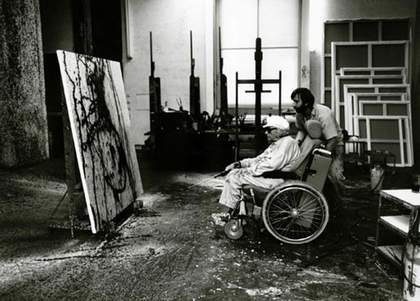
Fig.3
Hartung with Bernard Derderian 1989
Photo: André Villers © Fondation Hartung Bergman
Assistants who stayed with Hartung for a long period naturally came to understand and anticipate Hartung’s wishes. In 1985 Hartung was quoted in an interview as saying that he did not need to instruct his team of assistants much. ‘The sort of telepathy you establish after working together for a while,’ Hartung claimed, ‘makes everything run smoothly when you need it.’ The interviewer, however, went on to note that Hartung, although more or less in a trance-like state while painting, partly induced by wine and an insulating barrier of Baroque music played extremely loudly, was careful to remain in contact with reality ‘to make sure his assistants, who prepare this colour or fetch that brush, are on their toes’.6
Following his illness in late 1986, and subsequent bouts of worsening health, it seems that Hartung was no longer concerned to impose his will in quite the same way as before. The size of canvases on which Hartung worked was determined on a day-to-day basis by the assistants. They also chose the colours of the grounds of the canvases, which they painted, and prepared the range of colours that were to be used in any one day, without much, if any, consultation with the artist. While Hartung painted, the assistants stood ready with the next sprayer to hand to him, following an agreed understanding of what tool was necessary and when. One type of sprayer would produce a fine mist of paint or, with an adjustment to the nozzle, more defined areas of colour with more or less random patches of opacity, while another made the great arcs and nervously wandering lines that were the hallmarks of Hartung’s late works. (The film shows the assistants explaining to the artist what effect a particular nozzle setting would achieve, and Hartung testing the effects by spraying onto the ground beside him.) Different degrees of liquidity were also used to create effects ranging from mist-like droplets to quite messy splashes of paint.
Hartung could have rejected the assistants’ choice of canvases and coloured grounds; he could also have declined to use the particular colours they mixed up for each day’s work. However, for the most part, he accepted what was done for him. Infirmity seemed to have made him either unwilling to seek to control such matters or simply accepting of the situation. For Derderian, it was as if Hartung was willing to accept and play with the cards dealt him as in a game, the rules of which he himself had established before his stroke. It could be said that, rather than being in control of the studio system, Hartung was now sustained by it. But it was, nonetheless, the system he had put in place.
As demonstrated in the film, Hartung was fully capable of producing the late canvases whose energy and ambition astounded so many contemporary commentators. Hartung painted all the marks on the surface of the canvases and, crucially, decided when a painting was finished and was to be taken away. At one point in the film, the assistant Bernard Derderian appears to lean over to ask Hartung whether a work is finished; Hartung nods and says a few words; Derderian gives a thumbs-up sign and jokingly shakes Hartung’s hand in congratulations; and the painting is removed. Amazingly, the process of painting most canvases, even the largest, did not take more than a few minutes. The only limit to the numbers that would be produced in a day was the floor space needed to lay the canvases flat to dry without paint runs spoiling the effect – an effect of which, the film makes clear, Hartung was in control.
However, Hartung’s physical incapacity, the growing number of lapses in his attentiveness and short-term memory, and, above all, the introduction of the new expansive imagery in the late years, lent credence to rumours that the assistants painted some or all of these late works. The video of Hartung at work in 1989 was made expressly to refute these rumours, which nonetheless still surface from time to time today. Technically simple, the late works might seem easy to imitate, but it is worth remarking that, had assistants wanted, for whatever reason, to fake Hartung’s work, they surely would have chosen to stay within the compass of his previously established style, using colours, formats and techniques that were recognised as typical. Instead of this, the very late works surprised all those who knew Hartung. The director of the Kunstsammlung Nordrhein-Westfalen, Werner Schmalenbach, for example, was astonished by what he described as the youthfulness of the works he saw during a visit to Hartung’s studio in 1988: ‘These are not at all the paintings of an old man. They exude the amazing youth Hartung has managed to preserve despite old age, illnesses, and the death of his wife, Anna-Eva.’7
A new phase
Writing about the late works of the abstract painter, Willem de Kooning, Robert Storr addressed not only the specific issues arising from the American artist’s creeping Alzheimer’s over the course of the 1980s but also the more general question of the constraints and opportunities brought to a painter by old age. He wrote:
Age and sickness debilitate, but they are also catalysts. Those stricken (and eventually no one is spared) might seem less themselves in gross terms, but, in subtler ways they may be simply ‘other’, or different than they were, in order to maintain a more essential continuity of being. Whether a person succeeds in adapting positively to extreme conditions is a consequence of self-knowledge, discipline, support, and unforeseeable good luck in the unfolding of natural misfortune. It is not so much that miracles happen as that the infirmities that inevitably betray us are not always so simple or complete as their onset and symptoms portend. Thus, while the forfeiture of strengths is implicit in the human condition, so too is their constant metamorphosis.8
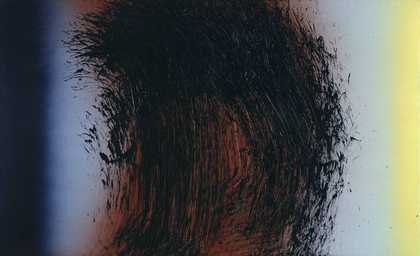
Hans Hartung
T1982-E15 (1982)
Tate
As Storr notes, it is a mistake to generalise about the weaknesses imposed by age and infirmity: the debilities are rarely constant, and while some faculties may be lost, others may continue and even, in stripped-down form, flourish. There were clearly ‘good’ days and ‘bad’ days for Hartung. An analysis of his production by month, for example, shows an enormous variation in his ability and desire to paint (see Appendix A). In 1987 he produced twenty-nine canvases in March, the first month he returned to painting after his stroke, but more or less nothing again until the autumn. In 1988 he produced twenty-six canvases in January and twenty-four in February, but this was followed by a period of five months when he again produced almost nothing until August. However, this pattern was entirely similar to that of the early 1980s, when travels and ill health contributed to sometimes extensive periods of inactivity. In 1981, for example, he produced only nine works in January and nothing again until August. In 1984 he worked only in February, March and April. In other words, Hartung’s ability and desire to paint may have waxed and waned but it may perhaps be assumed that he only painted when he both wanted to do so and felt that he could.
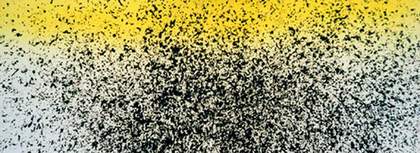
Fig.5
Hans Hartung
T1985-H30 1985
Acrylic on canvas 70 x 190 cm
© Fondation Hartung Bergman
Against this background of an uneven working pattern, how do the late works relate to what had preceded them, and when did significant shifts in style and technique occur? From 1979–80 to late 1986 Hartung used branches, taken from the olive trees that surrounded the studio, with which to paint. Typically, he would thrash the paint-dipped branches against the canvas. Such was the force used by Hartung – a man who had strong upper arms from having walked with the aid of crutches since 1944 – that the canvases had to be laid on wooden supports, or ‘isorels’, to prevent damage (these were then removed and the finished canvases were placed on conventional stretchers). Alternatively, two assistants would stand with a wooden support behind a canvas while Hartung thrashed the branches onto it.9 In works such as T1982-E15 (fig.5), mechanically sprayed vertical borders of blue and acid yellow frame a central red area over which brushes and branches dipped in black paint have been swept up and across the canvas. Such works spoke of a controlled contrast between order and unleashed energy.
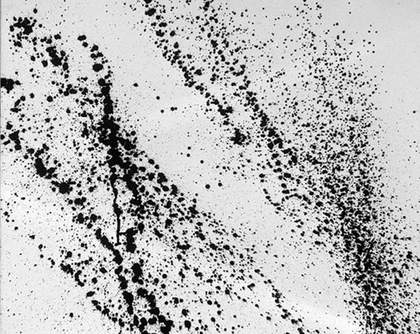
Fig.6
Hans Hartung
T1986-R22 1986
Acrylic on canvas
65 x 81 cm
Private collection © Fondation Hartung Bergman
Ever open to change, Hartung had introduced into his already extensive armoury of implements the ‘tirolienne’ in July 1985. This is a hand-held tool with which house painters spatter pebble dashing onto the walls of houses. In the first works in which the device was used (fig.6) Hartung created amorphous areas of black spatterings, relatively dense in the centre and airy towards the edges, on grounds painted pale blue or blue with yellow. The effects of this tool were relatively crude, and, because it was quite heavy to carry when filled with paint, it was not a solution to the problem of Hartung’s declining physical strength. In a video interview, the assistant Alkis Voliotis recalled that in 1986 Anna-Eva had telephoned him to ask if he might be able to find a new tool with which to help Hartung continue to paint.10 His solution was a sprayer, or ‘sulfateuse’, normally used by gardeners to spray herbicide or water in gardens and by viticulturists to spray copper sulphate solutions on vines. It consisted of a metal canister with a flexible hose leading to the handle which had a trigger and a long spraying rod. The canister needed to be pumped ten or so times to create enough pressure to force liquid through the nozzle when the trigger was depressed. Hartung had used compressed air to spray paint since the 1960s but this had involved lifting relatively heavy canisters of paint and wearing a protective mask in order not to inhale the spray. It was difficult, too, to achieve anything other than an even – and clearly mechanical – application of paint. With a ‘sulfateuse’, however, the canister could be left on the ground and all that had to be held was the light wand of the spraying rod. Above all, with its adjustable nozzle, the sprayer could be used to create both fine and thicker lines of spattered droplets, as well as areas of solid colour. The spray might last only for a minute or so but this drawback could be overcome by having several canisters available. Light and small, it allowed Hartung to project great sweeping lines of paint with a simple flick of a wrist. The artist may have had difficulty controlling a pen in his last years but, as the film shows, he was able to twist his forearm and when necessary lift his right arm to shoulder height – and these small movements were sufficient to paint canvases that were several metres wide and high.
Hartung immediately took to the sprayer. The records show that on the first day he used the ‘sulfateuse’ – 6 August 1986 – he experimented with black acrylic on canvas and ink on board, creating sometimes simple, sometimes more complex, images of wandering lines (fig.7). Clearly entranced with the new tool, Hartung produced no fewer than 106 canvases and works on paper that month.
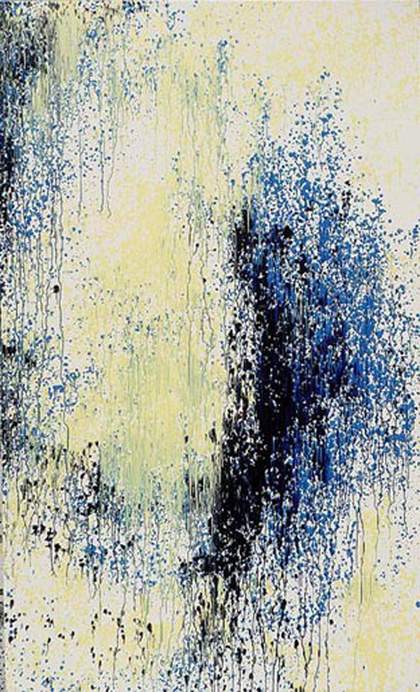
Fig.7
Hans Hartung
T1987-H1 1987
Acrylic on canvas
250 x 154 cm
© Fondation Hartung Bergman
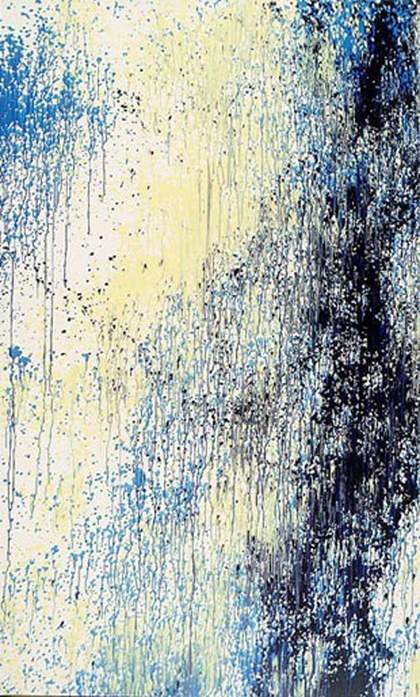
Fig.8
Hans Hartung
T1987-H2 1987
Acrylic on canvas
250 x 154 cm
© Fondation Hartung Bergman
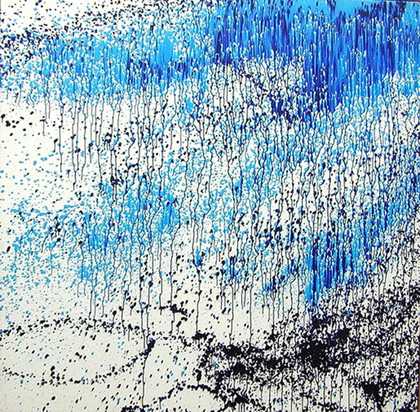
Fig.9
Hans Hartung
T1987-H3 1987
Acrylic on canvas
180 x 180 cm
© Fondation Hartung Bergman
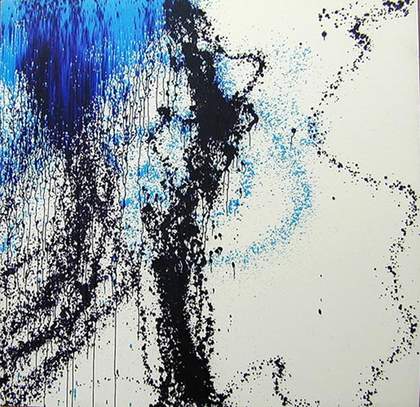
Fig.10
Hans Hartung
T1987-H4 1987
Acrylic on canvas
180 x 180 cm
© Fondation Hartung Bergman
When Hartung returned to the studio after his stroke, in March 1987, his options for painting were, of course, limited. As had already been clear in 1986, he no longer had the strength and manual control to aint vigorously, an enormous blow for an artist whose whole career had been predicated on and sustained by a decisive, almost violent, gesturalism. But rather than return to painting in a tentative or timid way, he specifically asked to work on large-format paintings. On 10 March, his first day back in the studio, he worked on two canvases each measuring 250 x 154 cm and a diptych measuring in all 180 x 360 cm (figs.9, 10). With the use of the ‘sulfateuse’ and a palette of pale blue, a darker blue, a lemon yellow and black, Hartung was able to create images that were gestural and painterly, combining interlacing lines with sometimes textured patches of colour of various degrees of density. This choice to work on large-format canvases – something that became the norm in this later period – spoke of confidence in himself and in the tools at his disposal. This confidence was to be increased by his use of a second type of spray, known as ‘l’airless’, from the beginning of 1989).11 Used normally by house painters to paint large areas, or car mechanics to paint the bodywork of cars, this spray could be used to create relatively even mists of background colour or random patches of greater density. In 1988 Hartung briefly used the five-brush tool, similar in form to a rake that he had used in the 1970s, but the resulting few paintings offered no way ahead and the experiment was not extended (fig.12). Fine mists, thicker ‘clouds’, paint runs and freely doodled lines were to be the formal language of Hartung’s last years. None of this would have been possible without the simple, if unorthodox, technology discovered by the studio assistants. This was, in Storr’s phrase, the piece of ‘unforeseeable good luck in the unfolding of natural misfortune’ that made it possible for Hartung to continue to work as an artist.

Fig.11
Hans Hartung
T1988-H9 1988
Acrylic on canvas
89 x 146 cm
© Fondation Hartung Bergman

Fig.12
Hans Hartung
Untitled ?1927
Ink on paper
12 x 7.2 cm
© Fondation Hartung Bergman
From this point on – albeit somewhat spasmodically – Hartung went on to paint some of the freest, most ambitious, largest and most colourful works of his entire career. Enormous scale held no terrors, and he painted several grand canvases of five metres width. Some of his paintings presented radically off-centred images of freely doodled lines that went off the edges of the canvas. Combined with areas of colour and texture, some of the wilder images showed a knowing disregard for traditional composition, and even tested the stylistic conventions that had characterised much of Hartung’s work to date. Some canvases, for example, relied not on line but on colour applied in layers of wet paint that were allowed to run together, creating a highly textured patterning. With their splashes and seemingly random lines, other images could be read as both manifestations of energised paint and images of inchoate matter within the natural world. Spontaneous and experimental by nature, not all the late works can be judged successes, but the best of them spoke of a grand ambition and a complex interplay of moods and emotions.
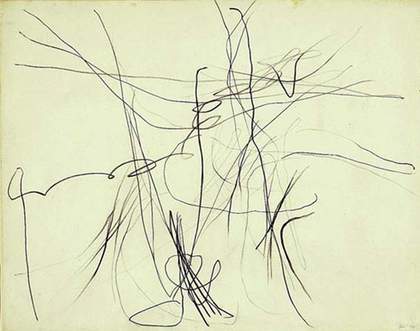
Fig.13
Hans Hartung
Untitled ?1935
Crayon on paper
49 x 65 cm
© Fondation Hartung Bergman
Were these freer compositions expressions of a ‘late style’ or an ‘Alterstil’? Should the distinct changes in Hartung’s style in these last years be compared to the fresh ambition and shift away from naturalism shown in the late Water-lily paintings by Monet? Or the radical simplification of forms and joyousness of Matisse’s late paper cutouts? Or the schematic quality and focus on mortality found in Picasso’s late works? Whatever answers are given to these questions, it is easy to believe that advancing age and physical decline gave Hartung an incentive to focus on exploring those aspects of his artistic identity that he could still access. Where he had once been forceful, explosive even, and in control, he was now more open to expressing through gesture chance, disorder and emotions that embraced awe, delight and foreboding.
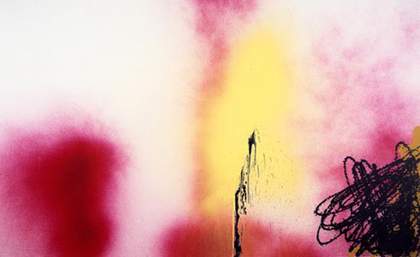
Fig.14
Hans Hartung
T I989-R45 1989
Acrylic on canvas
154 x 250 cm
© Fondation Hartung Bergman
Both these aspects had always been present in his work, even if the former had generally dominated. The free cursive gestures, the courting of chance and the use of sweeter colours in the late years had antecedents in earlier works. Although on a quite different scale, various drawings that Hartung made in the 1920s and 1930s seem to anticipate the graphism of the later works (see figs.13, 14). The atypical colours found in the late works, however, marked a distinct shift. Hartung had often said that he preferred sombre colours and actively disliked sweet colours, particularly pinks and reds,12 though in the 1970s he did for a period begin to use warmer colours. This is an area where the assistants seem to have played a particular role, choosing colours that were not typical of Hartung’s tastes but which nonetheless had been used by the artist at some point in the past (fig.15). A comment made by Hartung in an interview of August 1988 to the newspaper Libération may indicate that he did not feel strongly about the choice of colours in his paintings of this period: ‘I abuse them. Usually, they’re the ones who decide.’13 This should perhaps be read as code for the simple fact that the colours, and the sequence of their use in particular paintings, were generally decided by the assistants. For good or ill, the assistants broadened Hartung’s typical palette, but did so in the knowledge that he himself had experimented from time to time with a range of colours. Hartung’s acceptance – and perhaps even welcoming of the intervention of others – in this area can be seen as an expression of his weakened faculties. It may also be seen, however, as another aspect of the complex interplay of control and chance involved in the late works.
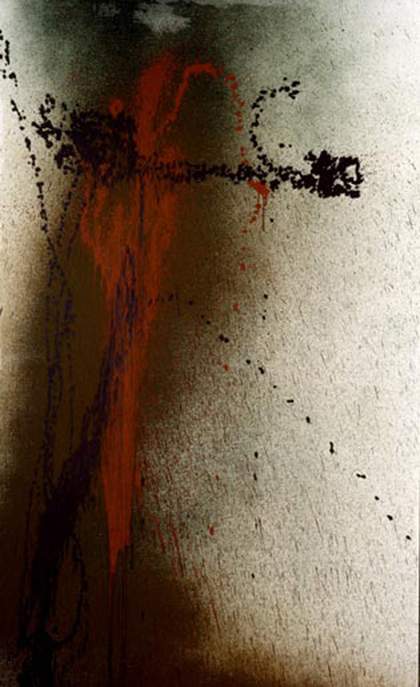
Fig.15
Hans Hartung
T I 989-L37 1989
Acrylic on canvas
250 x 154 cm
© Fondation Hartung Bergman
Reception
The new developments in Hartung’s art were not viewed uniformly positively by those around him. One assistant, who, it should be noted, was trained as a restorer and had had enormous respect for Hartung’s mastery of technical matters, found it difficult to accept these very late works, which seemed to him to be lacking in authorial control and to be a product of infirmity. For a period in 1987 the atmosphere in the studio was poor, and this affected Hartung’s ability and willingness to paint. The arrival of Bernard Derderian in April 1987 and the recruitment of other, younger assistants changed the situation. As Derderian noted in an interview given in 1996, the newer assistants tended to be much more aware of the conceptual underpinning of the development of modem art, and had no difficulty in accepting the technical simplicity of Hartung’s late paintings as being as valid as more complex ways of working. He added that throughout Hartung’s career there had been teams of assistants whose particular skills and interests corresponded to the needs and direction of Hartung’s painting at the time. ‘Those who admired the gesture of the 1950s or the virtuosity of the 1960s started to leave when they thought Hartung’s paintings had become too random,’ he said. ‘Those of us who were just arriving belonged to a new generation that was not really that interested in technique. And, anyway, stretching canvases and using vinyl paint had become very easy.’14
Hartung’s recent works were included in a number of exhibitions in the years 1987–9, and engendered a uniformly positive response from press critics.15 Writers typically marvelled at Hartung’s inventiveness at an age when other artists had long since ceased to paint at all, and were struck by both the scale and what they saw as the sheer beauty of some of the late works. One reviewer of an exhibition of Hartung’s recent works, for example, commented in Art Press in January 1988:
From 1986 on, Hartung slowly started replacing the big brushes he had been using – and which left such large and colourful evidence of their passage on the canvas – with paint sprayers. He had alighted upon the means of projecting, by means of different systems, the liquid colours of his palette onto a vertical frame … The energy of the spontaneous act he had achieved by the concentration of the gesture is still there, in the way the paint atomises the moment it hits the canvas. With the resulting graphic and coloured lines (black being much more present in his recent paintings) Hartung opens up a new world of immense beauty for abstraction, in which the dozen or so paintings on display at the Daniel Gervis Gallery are so many planets.’16
In the preface to the catalogue of a showing of Hartung’s recent work held in autumn 1988 in Paris, the artist’s age was contrasted with the youthfulness of the work, and a parallel with late Picasso was drawn: ‘In a creative outpouring reminiscent of Picasso’s last efforts, Hartung, who’s already past eighty, is still making the most unexpected and the “youngest” paintings you could imagine, and in astonishing numbers.’17 In the same catalogue the writer Daniel Abadie noted that the simple ‘sulfateuse’ allowed Hartung such freedom to create that each canvas had its own individuality and tonality. He went on to suggest that the expansive imagery created by the droplets of paint was, in effect, a metaphor for Hartung’s vision of nature:
In many of the paintings from this series, Hartung juxtaposes canvases with an elongated format … By thus recreating a unity with disparate elements, he shows that the painting is just a fragment from a much vaster body, much as the lines that cut across them are, to the attentive viewer, no more than myriad points in succession. It is the same discontinuity that governs the universe: an atomic structure that his paintings, in their fragmentation, try to echo.18
Hartung himself appears to have believed that his new works expressed profound aspects of his vision of painting’s relationship with material reality and energy. In the interview given to Libération and published in August 1988, he said: ‘The age, the view of the world, now aggressive, now sweet, positive or negative depending on the moment, and this wish to live, to be part of life, are the things I try to express in my paintings’. He also spoke of his continued fascination with energy and speed. ‘They allow me to evoke atmospheric and cosmic tensions, the energies and forces that govern the universe. These are the vital, natural, and physical forces that I have always expressed in the gesture. That’s only normal: if you’re furious, you smack someone in the face. Well, the same goes for painting: the vigorous sign you make is always the expression of something. It must be as accurate as possible … I like the gesture to be definitive; I don’t want to have to come back to it, unless of course it didn’t come out quite right. From this improvisation on the canvas, this spontaneity comes the rhythm and the intensity.’19 In this interview Hartung seemed very much aware of his personal situation. He had been unable to paint recently because of a back problem, commenting ruefully: ‘I’m not painting at all right now. I worked very hard at the beginning of the year, on large paintings especially, and maybe it was because of the effort they demanded that I’ve had to take a break from working following a compression of the spinal column’. The records of the Fondation Hartung Bergman indicate that Hartung had produced practically nothing in the previous four months, but that from August, recovered from his back problem, he returned to a more regular rate of production, completing 206 canvases and ten works on paper that year.
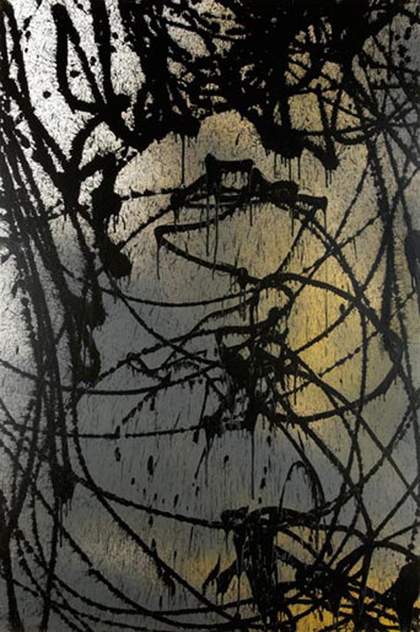
Fig.16
Hans Hartung
T1989-L37 1989
Acrylic on canvas
195 x 130 cm
© Fondation Hartung Bergman
The steady and prolific rate of production of the last year of Hartung’s life is one of the most telling points in the story of the late works. If 1987 saw a slow recovery from the stroke and a trying resolution of difficulties within the studio, and if 1988 saw a steadier production but one nonetheless dogged by the pain of his collapsed vertebrae, 1989 saw Hartung averaging nearly thirty-three paintings a month for the eleven months he worked, or, alternatively expressed, between five and six canvases a day for the sixty-two days he worked in the studio that year.20 Each work was unique in its colours and composition, and each had its own distinctive mood and emotional quality. The variety and quantity of his production can be seen as an expression of Hartung’s profound sense of the eternal flux that lay at the core of the material world and our apprehension of it, something which had underlain his work from the earliest days of his recording lightning flashes while still a boy. No longer bothered to suppress accidental figurative allusions within his works, Hartung allowed some images to suggest crucifixions, a motif of his early figurative work and thus, perhaps, made a knowing allusion to his early preoccupations.
In 1988 Hartung commented, ‘Our position to life changes because life itself is constantly changing. So that there is always something else to express, you’re always trying to go one step further. You enjoy painting as you enjoy life. You can’t stop’. Those who knew him and worked alongside him believe that in these last years Hartung focused on what he could do, and did not bother himself with the negative aspects of his condition. Marie Aanderaa, his long-term personal assistant, said of him, ‘Hartung in his latest years, being freer than ever, only lived for his painting. Not having much time left over, he knew or chose (or does one really know or choose?) what was essential to him and left aside everything else.’21 The late paintings would not have existed were it not for the somewhat fortuitous discovery of the sprayers, Hartung’s openness to working with new tools and his need to do so. But clearly there is something more at play in these works than these material circumstances, fundamental though they were. Paradoxically, it would seem that the proximity of death allowed Hartung a freedom to go beyond what was familiar, while the reduction in his physical strength and his mental faculties permitted a renewed enjoyment of the sensuous aspects of painting. Astonishingly, old age and a stroke had not denied Hartung the ability to remain in contact with the forces within himself that had always driven his work forward. Instead, Hartung was able to continue to find pleasure in painting, and maintain the link between expression and energy that lay at the core of his work.
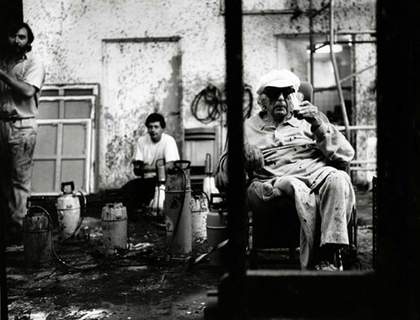
Fig.17
Bernard Derderian, Jean-Luc Uro and Hans Hartung in Hartung’s studio, 11 September 1989
Photo: André Villers © Fondation Hartung Bergman
Appendix
